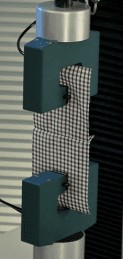
NewsInformation Center
Standard seam efficiency testing
2019/03/12
A seam is a series of stitches that may be functional or ornamental. The aesthetics and performance of the garment are strongly dependent on the seam’s appearance and performance characteristics. The considerations related to seam appearance include colorfastness and the area covered under the seam, as was discussed earlier in the thread testing section. Performance characteristics are more related to strength, elongation, and elasticity.In the face of such a complex information about the Fabric Tensile Strength Tester,many enterprises often feel helpless without knowing a good way to make bright choices.

Standard seam efficiency testing can be performed by using a tensile testing machine.First of all, fabric without a seam is placed between the clamps of a tensile testing machine and force is applied until failure occurs. The amount of force required to break the fabric sample is noted. Then, a sewn sample of woven fabric is prepared as explained in ASTM-D1683. The sewn sample size is 4 in. × 8 in. Seam allowance should be 1/2 in. To test seam strength, the fabric specimen containing the seam is placed between the two jaws of a tensile testing machine such that it is directed toward the rear of the machine, using vertical alignment guides. The seam should also be equidistant from the upper and lower clamps of the testing machine. The force is applied until the thread breaks and seam failure occurs. The amount of force required to break the seam is noted.
Apart from seam efficiency, seams are inspected for various parameters. Seam slippage, as described in fabric inspection, is a major fault, though one not caused by the seam itself, yet it destroys the aesthetics and functioning. A miss stitch is a major seam fault owing to which the seam fails to grip one or more plies of the fabric in the seaming process. A seam may also be inspected for its appearance. Sometimes the lower thread appears on top and deteriorates the seam’s appearance. Such a problem is usually caused by improper tension setting of the machine and can be rectified with a little care. Ideally, the lower and bottom threads should meet at the center point of the fabric plies. Seams are also inspected for too many protruding fibers on the sewing thread, which indicates rough contact with the surfaces of the guides or the needle eye. Friction can be overcome by lubrication and appropriate thread selection. Finally, seams are also checked for the appropriate stitch and seam types with respect to the location of usage or customer directions.
Previous: Methods of Textile Testing
N e x t : Detailed Test Procedures of oxygen Index



